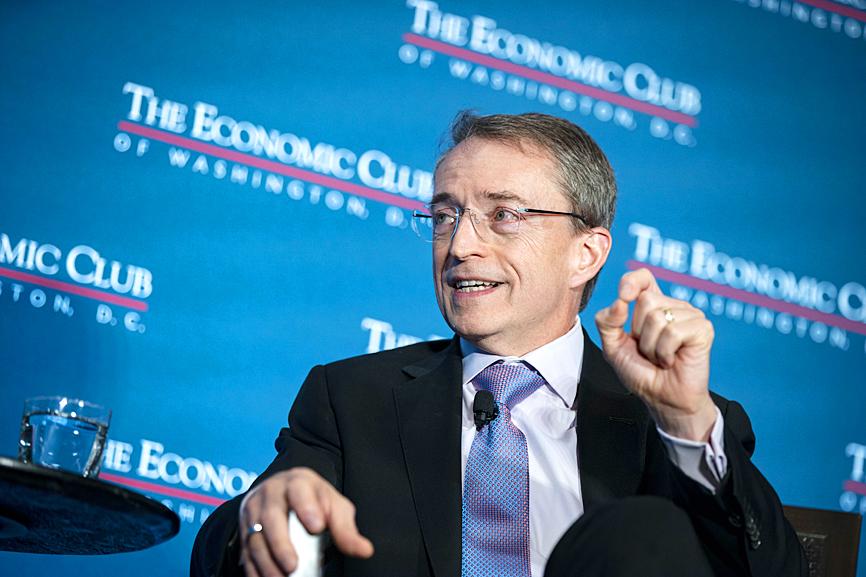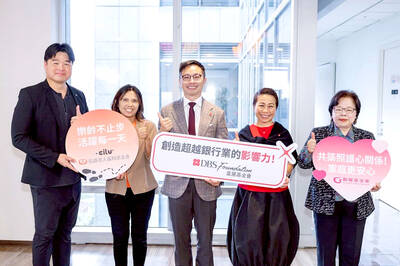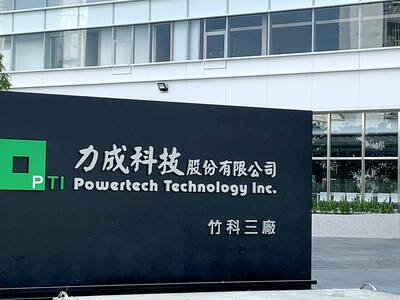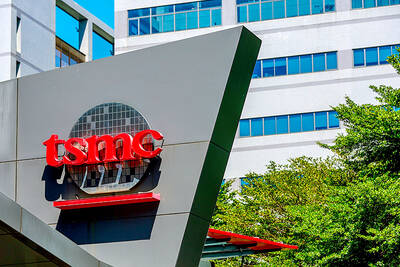Intel Corp CEO Pat Gelsinger is to visit Taiwan and Malaysia next week for talks that show how manufacturing in Asia is crucial to his efforts to turn around the fortunes of the world’s largest chipmaker by revenue.
Gelsinger’s trip is to include a meeting with leaders of Taiwan Semiconductor Manufacturing Co (TSMC, 台積電), people familiar with his plans said.
Intel needs TSMC’s advanced manufacturing services and plans to compete with the Taiwanese company in the foundry business, a tricky balancing act for the CEO.

Photo: Bloomberg
This is Gelsinger’s first trip to Asia since taking the top job at Intel earlier this year and comes as he publicly lobbies the US government to allocate money for the country’s chip industry to domestic companies only.
He has said that overseas manufacturers — such as TSMC and Samsung Electronics Co, which both have plans to build plants in the US — should not get money through the Chips Act, which is going through political approvals in Washington.
As part of those efforts, he has said that the concentration of advanced manufacturing in Taiwan is a strategic risk.
TSMC is both a threat to Intel and an interim solution to issues that have seen the US giant lose manufacturing leadership in the chip industry, the foundation of its dominance for three decades.
Rivals such as Nvidia Corp and Advanced Micro Devices Inc use TSMC’s production to make chips they say are better than Intel’s offerings. Market share losses and weak earnings from Intel have helped bolster their case.
Part of Gelsinger’s answer to that is a strategy for combining parts of processors made by TSMC with other contributions from his own factories to produce more competitive computer components.
At the same time he is investing heavily to improve his own production to the point where he should no longer need TSMC’s cutting-edge production.
He plans to open factories that would make semiconductors for other companies, which is the foundry business model that TSMC pioneered.
While that gives TSMC some leverage, it is also left with some tricky decisions. The kind of production that Intel wants, and the huge volume of orders it could provide, are potentially lucrative for the Taiwanese company. Intel still has about an 80 percent share of the computer processor market.
Gelsinger has said that competition and cooperation between companies is nothing new and technology is full of such arrangements.
Intel has long used TSMC for manufacturing of less-important support chips for computers and other parts of its portfolio.
TSMC’s rapid rise has been built on navigating the complex web of rivalries among its customers, of guaranteeing impartiality and of pushing forward production technology quickly. Its customers include Apple Inc, Qualcomm Inc, Sony Group Corp, as well as Nvidia and AMD.
Gelsinger is also to visit Malaysia, where COVID-19-related shutdowns of plants have hurt chip supply for many companies.
Intel relies on the Southeast Asian country for some of its chip packaging operations, the critical last step in the semiconductor manufacturing process.

The DBS Foundation yesterday announced the launch of two flagship programs, “Silver Motion” and “Happier Caregiver, Healthier Seniors,” in partnership with CCILU Ltd, Hondao Senior Citizens’ Welfare Foundation and the Garden of Hope Foundation to help Taiwan face the challenges of a rapidly aging population. The foundation said it would invest S$4.91 million (US$3.8 million) over three years to foster inclusion and resilience in an aging society. “Aging may bring challenges, but it also brings opportunities. With many Asian markets rapidly becoming super-aged, the DBS Foundation is working with a regional ecosystem of like-minded partners across the private, public and people sectors

BREAKTHROUGH TECH: Powertech expects its fan-out PLP system to become mainstream, saying it can offer three-times greater production throughput Chip packaging service provider Powertech Technology Inc (力成科技) plans to more than double its capital expenditures next year to more than NT$40 billion (US$1.31 billion) as demand for its new panel-level packaging (PLP) technology, primarily used in chips for artificial intelligence (AI) applications, has greatly exceeded what it can supply. A significant portion of the budget, about US$1 billion, would be earmarked for fan-out PLP technology, Powertech told investors yesterday. Its heavy investment in fan-out PLP technology over the past 10 years is expected to bear fruit in 2027 after the technology enters volume production, it said, adding that the tech would

YEAR-END BOOST: The holiday shopping season in the US and Europe, combined with rising demand for AI applications, is expected to drive exports to a new high, the NDC said Taiwan’s business climate monitor improved last month, transitioning from steady growth for the first time in five months, as robust global demand for artificial intelligence (AI) products and new iPhone shipments boosted exports and corporate sales, the National Development Council (NDC) said yesterday. The council uses a five-color system to measure the nation’s economic state, with “green” indicating steady growth, “red” suggesting a boom and “blue” reflecting a recession. “Yellow-red” and “yellow-blue” suggest a transition to a stronger or weaker condition. The total score of the monitor’s composite index rose to 35 points from a revised 31 in August, ending a four-month

Taiwan Semiconductor Manufacturing Co (TSMC, 台積電) has secured three construction permits for its plan to build a state-of-the-art A14 wafer fab in Taichung, and is likely to start construction soon, the Central Taiwan Science Park Bureau said yesterday. Speaking with CNA, Wang Chun-chieh (王俊傑), deputy director general of the science park bureau, said the world’s largest contract chipmaker has received three construction permits — one to build a fab to roll out sophisticated chips, another to build a central utility plant to provide water and electricity for the facility and the other to build three office buildings. With the three permits, TSMC